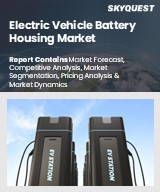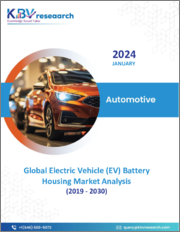
|
시장보고서
상품코드
1422666
전기자동차(EV)용 배터리 하우징 시장 규모 : 셀 형식 유형별, 소재별, 차종별 및 예측(2024-2032년)Electric Vehicle Battery Housing Market Size -, By Cell Format Type, By Material, Vehicle Type & Forecast, 2024 - 2032 |
||||||
세계의 전기자동차(EV)용 배터리 하우징 시장은 지속가능한 운송 솔루션을 지지하는 규제 구조에 의해 지원되며, 2023-2032년 CAGR 8%로 성장합니다. 정부의 구상은 세계에서 EV로의 이동을 우선하고 있으며, 배터리 하우징의 수요를 촉진하고 있습니다. 또한 확대하는 충전 인프라가 이 이동을 보완하며, EV 사용자에게 편리성과 접근성을 제공하고 있습니다. 이러한 노력이 결합되어 전기자동차(EV)용 배터리 하우징 산업의 규모를 확대시키는 환경이 조성되고 있습니다.
예를 들어 2023년 Charge Zone은 180kW 듀얼건 충전기와 360kW 파워 캐비닛을 갖춘 전기자동차용 최신식 360kW 슈퍼차징 네트워크를 도입했습니다. 이 충전소는 전기자동차 충전 인프라의 최첨단 솔루션으로 전기자동차 사용자에게 효율적이고 대용량 충전 기능을 제공합니다.
원통형 배터리는 전기자동차 배터리 팩에 일반적으로 사용되는 원통형 배터리의 보급으로 2032년까지 크게 성장할 것입니다. 원통형 배터리는 컴팩트한 형태와 효율적인 포장으로 전기자동차 배터리의 전반적인 공간 활용과 성능에 기여합니다. 전기자동차에 대한 수요가 지속적으로 증가함에 따라 원통형 셀 부문은 전기자동차(EV) 배터리 하우징 산업에서 강세를 유지할 것으로 보입니다.
유리섬유 강화 폴리머 부문은 2032년까지 EV 배터리 하우징 시장에서 상당한 점유율을 차지할 것입니다. 자동차 제조업체들이 경량화 및 안전 조치를 점점 더 우선시함에 따라 GFRP 기반 배터리 하우징에 대한 수요가 급증할 것입니다. 이러한 추세는 GFRP를 전기자동차(EV) 배터리 하우징 시장 규모를 형성하는 중요한 기업으로 자리매김할 것입니다.
아시아태평양의 전기자동차 배터리 하우징 산업은 중국, 일본, 한국 등의 국가에서 전기자동차의 급속한 보급에 힘입어 2023-2032년 연평균 성장률(CAGR)이 두드러질 것으로 예상됩니다. 정부의 적극적인 지원 정책, 지원 정책, 탄탄한 제조 역량이 이 지역의 선도적 지위에 기여하고 있습니다. 지속가능한 운송에 대한 관심이 높아짐에 따라 APAC 시장은 EV 배터리 하우징 솔루션의 성장에 매우 중요한 역할을 할 것으로 보입니다.
목차
제1장 조사 방법과 조사 범위
제2장 주요 요약
제3장 전기자동차(EV)용 배터리 하우징 산업의 인사이트
- 에코시스템 분석
- 공급업체 상황
- 자동차 제조업체
- 배터리 제조업체
- 재료 공급업체
- 이익률 분석
- 기술 혁신 상황
- 특허 분석
- 주요 뉴스와 구상
- 파트너십/협업
- 합병/인수
- 투자
- 제품 출시와 혁신
- 규제 상황
- 영향요인
- 촉진요인
- 환경 문제에 대한 의식의 향상
- 정부 구상의 증가
- 규제에 대한 높은 관심
- 안전 요건의 증가
- 업계의 잠재적 리스크 & 과제
- 전기자동차 배터리와 그 부품을 재활용하기 위한 인프라의 제한
- 안전성과 규제의 준수
- 촉진요인
- 성장 가능성 분석
- Porter의 산업 분석
- PESTEL 분석
제4장 경쟁 상황
- 서론
- 각사의 시장 점유율
- 주요 시장 기업의 경쟁 분석
- 경쟁 포지셔닝 매트릭스
- 전략 전망 매트릭스
제5장 전기자동차(EV)용 배터리 하우징 시장 추산·예측 : 차종별
- 주요 동향 : 차종별
- 전기자동차
- 이륜차·삼륜차
- 승용차
- 상용차
- 하이브리드&플러그인 하이브리드 EV
- 승용차
- 상용차
제6장 전기자동차(EV)용 배터리 하우징 시장 추산·예측 : 셀 형식 유형별
- 주요 동향 : 셀 형식 유형별
- 원통형 셀
- 파우치형 셀
- 각형 셀
제7장 전기자동차(EV)용 배터리 하우징 시장 추산·예측 : 재료별
- 주요 동향 : 소재별
- 알루미늄
- 철강
- 마그네슘
- 유리섬유 강화 폴리머
- 탄소섬유 강화 폴리머
제8장 전기자동차(EV)용 배터리 하우징 시장 추산·예측 : 지역별
- 주요 동향 : 지역별
- 북미
- 미국
- 캐나다
- 유럽
- 영국
- 독일
- 프랑스
- 이탈리아
- 스페인
- 러시아
- 아시아태평양
- 중국
- 인도
- 일본
- 한국
- 호주
- 라틴아메리카
- 브라질
- 멕시코
- 아르헨티나
- 중동 및 아프리카
- UAE
- 남아프리카공화국
- 사우디아라비아
제9장 기업 개요
- Constellium SE
- Gestamp Automocion
- UACJ Corporation
- GF Linamar LLC
- Hanwha Advanced Materials
- Minth
- Continental Structural Plastics
- ThyssenKrupp AG
- TRB Lightweight
- Hitachi Metals Ltd.
- POSCO
- Norsk Hydro ASA
- SGL Carbon
- Nemak
- Novelis Inc
- Covestro AG
- Magna International
- Teijin Limited
- LANXESS
- Evonik Industries AG
Global Electric Vehicle (EV) Battery Housing Market will grow at 8% CAGR from 2023 to 2032, propelled by regulatory frameworks favoring sustainable transportation solutions. Government initiatives globally prioritize the transition to EVs, fostering demand for battery housing. Furthermore, the expanding charging infrastructure complements this shift, providing convenience and accessibility for EV users. These combined efforts create a conducive environment, driving the size of the electric vehicle (EV) battery housing industry.
For instance, in 2023, Charge Zone introduced its state-of-the-art 360 kW supercharging network for electric vehicles, featuring 180 kW dual-gun chargers and 360 kW power cabinets. These stations represent a cutting-edge solution in the EV charging infrastructure, providing efficient and high-capacity charging capabilities for electric vehicle users.
The overall electric vehicle (EV) battery housing industry is segmented based on type of cell format, material, and region.
The cylindrical cell segment will experience a significant upswing by 2032, attributed to the prevalence of cylindrical cell designs, which are commonly used in electric vehicle battery packs. Their compact shape and efficient packing contribute to the overall space utilization and performance of EV batteries. As the demand for electric vehicles continues to rise, the cylindrical cell segment will maintain its stronghold in the electric vehicle (EV) battery housing industry.
The glass fiber-reinforced polymer segment will gain a considerable EV battery housing market share by 2032, driven by GFRP's lightweight properties, offering structural strength and enhanced safety for EV battery enclosures. As automakers increasingly prioritize weight reduction and safety measures, the demand for GFRP-based battery housing will surge. This trend will position the GFRP segment as a key player in shaping the electric vehicle (EV) battery housing market size.
Asia-Pacific EV battery housing industry will register a notable CAGR from 2023 to 2032, fueled by the rapid adoption of electric vehicles in countries like China, Japan, and South Korea. Favorable government initiatives, supportive policies, and robust manufacturing capabilities contribute to the region's leading position. With an increasing focus on sustainable transportation, the APAC market will play a pivotal role in steering the growth of EV battery housing solutions.
Table of Contents
Chapter 1 Methodology & Scope
- 1.1 Market scope & definition
- 1.2 Base estimates & calculations
- 1.3 Forecast calculation
- 1.4 Data sources
- 1.4.1 Primary
- 1.4.2 Secondary
- 1.4.2.1 Paid sources
- 1.4.2.2 Public sources
Chapter 2 Executive Summary
- 2.1 Electric vehicle (EV) battery housing market 360 degree synopsis, 2018 - 2032
- 2.2 Business trends
- 2.3 Regional trends
- 2.4 Vehicle type trends
- 2.5 Cell format type trends
- 2.6 Material trends
Chapter 3 Electric Vehicle (EV) Battery Housing Industry Insights
- 3.1 Industry ecosystem analysis
- 3.2 Supplier landscape
- 3.2.1 Automobile manufacturers
- 3.2.2 Battery manufacturers
- 3.2.3 Material suppliers
- 3.3 Profit margin analysis
- 3.4 Technology & innovation landscape
- 3.5 Patent analysis
- 3.6 Key news and initiatives
- 3.6.1 Partnership/Collaboration
- 3.6.2 Merger/Acquisition
- 3.6.3 Investment
- 3.6.4 Product launch & innovation
- 3.7 Regulatory landscape
- 3.8 Impact forces
- 3.8.1 Growth drivers
- 3.8.1.1 Growing awareness of environmental issues
- 3.8.1.2 Rise in government initiatives
- 3.8.1.3 High focus on regulations
- 3.8.1.4 Increase in safety requirements
- 3.8.2 Industry pitfalls & challenges
- 3.8.2.1 Limited infrastructure for recycling electric vehicle batteries and their components
- 3.8.2.2 Safety and regulatory compliance
- 3.8.1 Growth drivers
- 3.9 Growth potential analysis
- 3.10 Porter's analysis
- 3.11 PESTEL analysis
Chapter 4 Competitive Landscape, 2023
- 4.1 Introduction
- 4.2 Company market share, 2023
- 4.3 Competitive analysis of major market players, 2023
- 4.4 Competitive positioning matrix, 2023
- 4.5 Strategic outlook matrix, 2023
Chapter 5 Electric Vehicle (EV) Battery Housing Market Estimates & Forecast, By Vehicle Type
- 5.1 Key trends, by vehicle type
- 5.2 Electric vehicles
- 5.2.1 Two wheelers & three wheelers
- 5.2.2 Passenger cars
- 5.2.3 Commercial vehicles
- 5.3 Hybrid & plug-in hybrid EV
- 5.3.1 Passenger cars
- 5.3.2 Commercial vehicles
Chapter 6 Electric Vehicle (EV) Battery Housing Market Estimates & Forecast, By Cell Format Type
- 6.1 Key trends, by cell format type
- 6.2 Cylindrical cells
- 6.3 Pouch cells
- 6.4 Prismatic cells
Chapter 7 Electric Vehicle (EV) Battery Housing Market Estimates & Forecast, By Material
- 7.1 Key trends, by material
- 7.2 Aluminum
- 7.3 Steel
- 7.4 Magnesium
- 7.5 Glass fiber-reinforced polymer
- 7.6 Carbon fiber reinforced polymer
Chapter 8 Electric Vehicle (EV) Battery Housing Market Estimates & Forecast, By Region
- 8.1 Key trends, by region
- 8.2 North America
- 8.2.1 U.S.
- 8.2.2 Canada
- 8.3 Europe
- 8.3.1 U.K.
- 8.3.2 Germany
- 8.3.3 France
- 8.3.4 Italy
- 8.3.5 Spain
- 8.3.6 Russia
- 8.4 Asia Pacific
- 8.4.1 China
- 8.4.2 India
- 8.4.3 Japan
- 8.4.4 South Korea
- 8.4.5 Australia
- 8.5 Latin America
- 8.5.1 Brazil
- 8.5.2 Mexico
- 8.5.3 Argentina
- 8.6 MEA
- 8.6.1 UAE
- 8.6.2 South Africa
- 8.6.3 Saudi Arabia
Chapter 9 Company Profiles
- 9.1 Constellium SE
- 9.2 Gestamp Automocion
- 9.3 UACJ Corporation
- 9.4 GF Linamar LLC
- 9.5 Hanwha Advanced Materials
- 9.6 Minth
- 9.7 Continental Structural Plastics
- 9.8 ThyssenKrupp AG
- 9.9 TRB Lightweight
- 9.10 Hitachi Metals Ltd.
- 9.11 POSCO
- 9.12 Norsk Hydro ASA
- 9.13 SGL Carbon
- 9.14 Nemak
- 9.15 Novelis Inc
- 9.16 Covestro AG
- 9.17 Magna International
- 9.18 Teijin Limited
- 9.19 LANXESS
- 9.20 Evonik Industries AG



















